HMSV3203: Change Management Plan for Health and Human Services
VerifiedAdded on 2023/06/10
|11
|3562
|129
Report
AI Summary
This change management plan outlines objectives for development of change leaders, empowering change agents, and aligning employee objectives within health and human services organizations. It emphasizes the benefit of rapid response to client needs and improved care quality through efficient infrastructure. Key components like organizational culture, stakeholder analysis, communication, leadership, and evaluation are discussed for successful change. The plan identifies risks such as lack of employee involvement, ineffective communication, and poor cultural planning. Key messages for stakeholders, including employees and directors, focus on their roles and benefits. Tools like project plans are suggested for the planning phase. Desklib offers a range of resources including past papers and solved assignments to support students.
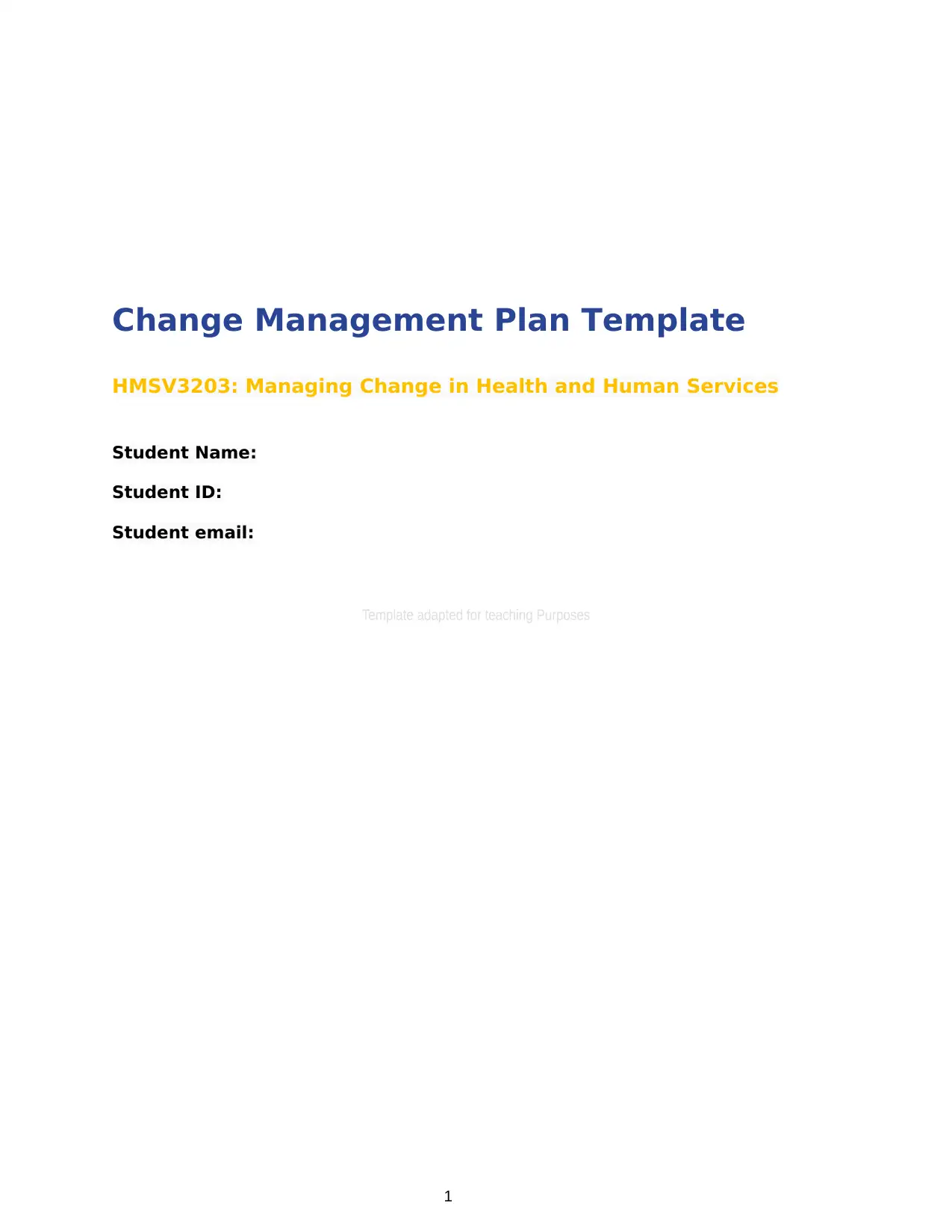
Change Management Plan Template
HMSV3203: Managing Change in Health and Human Services
Student Name:
Student ID:
Student email:
1
HMSV3203: Managing Change in Health and Human Services
Student Name:
Student ID:
Student email:
1
Paraphrase This Document
Need a fresh take? Get an instant paraphrase of this document with our AI Paraphraser
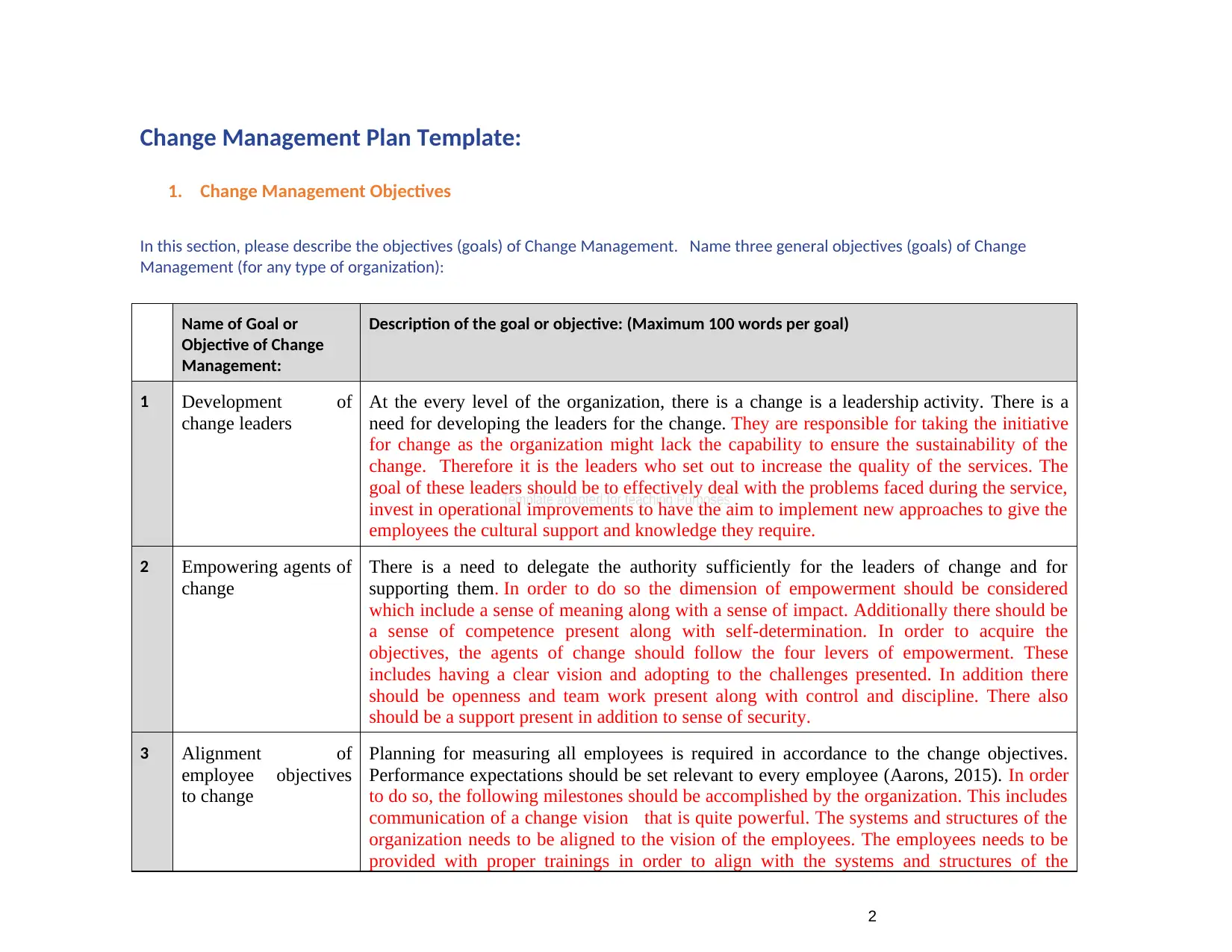
Change Management Plan Template:
1. Change Management Objectives
In this section, please describe the objectives (goals) of Change Management. Name three general objectives (goals) of Change
Management (for any type of organization):
Name of Goal or
Objective of Change
Management:
Description of the goal or objective: (Maximum 100 words per goal)
1 Development of
change leaders
At the every level of the organization, there is a change is a leadership activity. There is a
need for developing the leaders for the change. They are responsible for taking the initiative
for change as the organization might lack the capability to ensure the sustainability of the
change. Therefore it is the leaders who set out to increase the quality of the services. The
goal of these leaders should be to effectively deal with the problems faced during the service,
invest in operational improvements to have the aim to implement new approaches to give the
employees the cultural support and knowledge they require.
2 Empowering agents of
change
There is a need to delegate the authority sufficiently for the leaders of change and for
supporting them. In order to do so the dimension of empowerment should be considered
which include a sense of meaning along with a sense of impact. Additionally there should be
a sense of competence present along with self-determination. In order to acquire the
objectives, the agents of change should follow the four levers of empowerment. These
includes having a clear vision and adopting to the challenges presented. In addition there
should be openness and team work present along with control and discipline. There also
should be a support present in addition to sense of security.
3 Alignment of
employee objectives
to change
Planning for measuring all employees is required in accordance to the change objectives.
Performance expectations should be set relevant to every employee (Aarons, 2015). In order
to do so, the following milestones should be accomplished by the organization. This includes
communication of a change vision that is quite powerful. The systems and structures of the
organization needs to be aligned to the vision of the employees. The employees needs to be
provided with proper trainings in order to align with the systems and structures of the
2
1. Change Management Objectives
In this section, please describe the objectives (goals) of Change Management. Name three general objectives (goals) of Change
Management (for any type of organization):
Name of Goal or
Objective of Change
Management:
Description of the goal or objective: (Maximum 100 words per goal)
1 Development of
change leaders
At the every level of the organization, there is a change is a leadership activity. There is a
need for developing the leaders for the change. They are responsible for taking the initiative
for change as the organization might lack the capability to ensure the sustainability of the
change. Therefore it is the leaders who set out to increase the quality of the services. The
goal of these leaders should be to effectively deal with the problems faced during the service,
invest in operational improvements to have the aim to implement new approaches to give the
employees the cultural support and knowledge they require.
2 Empowering agents of
change
There is a need to delegate the authority sufficiently for the leaders of change and for
supporting them. In order to do so the dimension of empowerment should be considered
which include a sense of meaning along with a sense of impact. Additionally there should be
a sense of competence present along with self-determination. In order to acquire the
objectives, the agents of change should follow the four levers of empowerment. These
includes having a clear vision and adopting to the challenges presented. In addition there
should be openness and team work present along with control and discipline. There also
should be a support present in addition to sense of security.
3 Alignment of
employee objectives
to change
Planning for measuring all employees is required in accordance to the change objectives.
Performance expectations should be set relevant to every employee (Aarons, 2015). In order
to do so, the following milestones should be accomplished by the organization. This includes
communication of a change vision that is quite powerful. The systems and structures of the
organization needs to be aligned to the vision of the employees. The employees needs to be
provided with proper trainings in order to align with the systems and structures of the
2
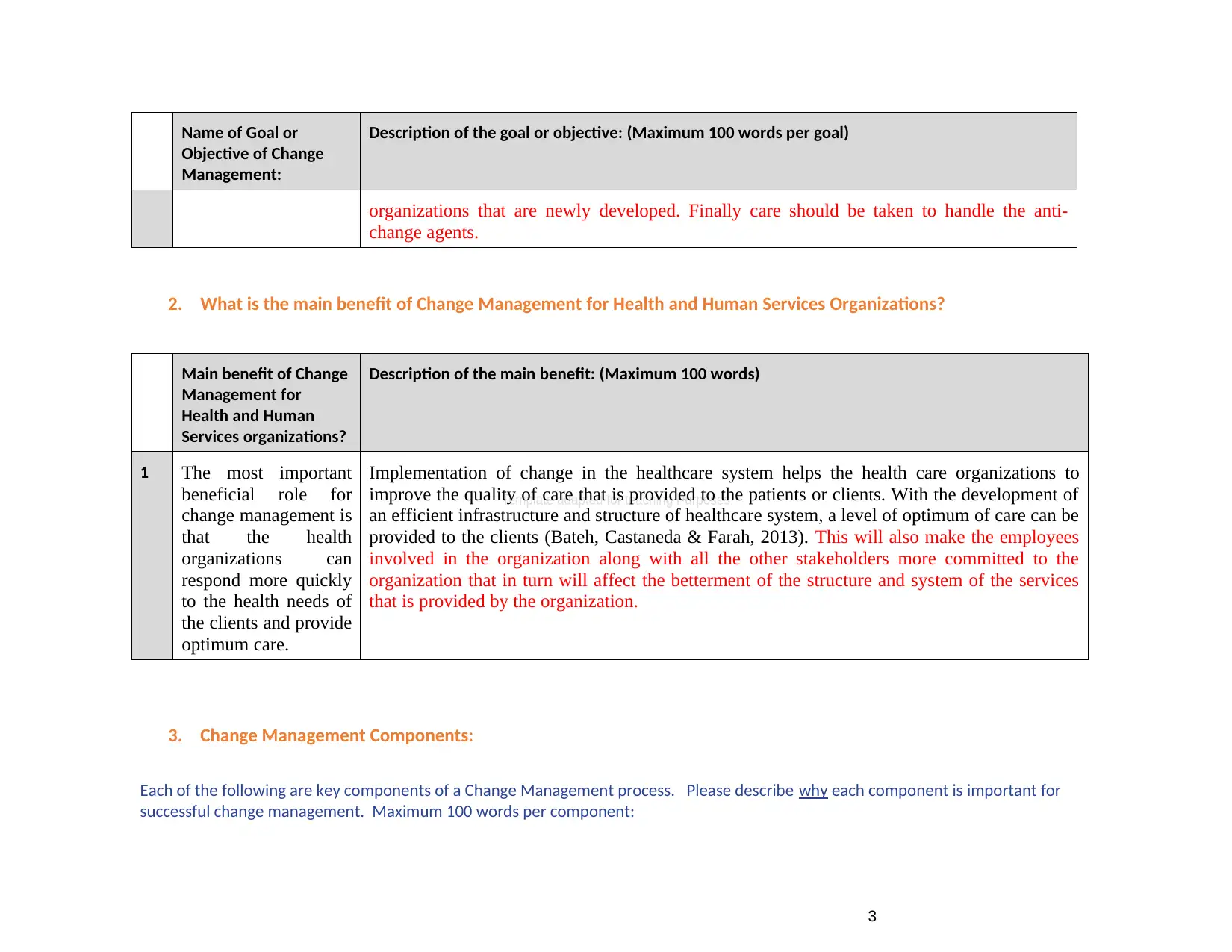
Name of Goal or
Objective of Change
Management:
Description of the goal or objective: (Maximum 100 words per goal)
organizations that are newly developed. Finally care should be taken to handle the anti-
change agents.
2. What is the main benefit of Change Management for Health and Human Services Organizations?
Main benefit of Change
Management for
Health and Human
Services organizations?
Description of the main benefit: (Maximum 100 words)
1 The most important
beneficial role for
change management is
that the health
organizations can
respond more quickly
to the health needs of
the clients and provide
optimum care.
Implementation of change in the healthcare system helps the health care organizations to
improve the quality of care that is provided to the patients or clients. With the development of
an efficient infrastructure and structure of healthcare system, a level of optimum of care can be
provided to the clients (Bateh, Castaneda & Farah, 2013). This will also make the employees
involved in the organization along with all the other stakeholders more committed to the
organization that in turn will affect the betterment of the structure and system of the services
that is provided by the organization.
3. Change Management Components:
Each of the following are key components of a Change Management process. Please describe why each component is important for
successful change management. Maximum 100 words per component:
3
Objective of Change
Management:
Description of the goal or objective: (Maximum 100 words per goal)
organizations that are newly developed. Finally care should be taken to handle the anti-
change agents.
2. What is the main benefit of Change Management for Health and Human Services Organizations?
Main benefit of Change
Management for
Health and Human
Services organizations?
Description of the main benefit: (Maximum 100 words)
1 The most important
beneficial role for
change management is
that the health
organizations can
respond more quickly
to the health needs of
the clients and provide
optimum care.
Implementation of change in the healthcare system helps the health care organizations to
improve the quality of care that is provided to the patients or clients. With the development of
an efficient infrastructure and structure of healthcare system, a level of optimum of care can be
provided to the clients (Bateh, Castaneda & Farah, 2013). This will also make the employees
involved in the organization along with all the other stakeholders more committed to the
organization that in turn will affect the betterment of the structure and system of the services
that is provided by the organization.
3. Change Management Components:
Each of the following are key components of a Change Management process. Please describe why each component is important for
successful change management. Maximum 100 words per component:
3
⊘ This is a preview!⊘
Do you want full access?
Subscribe today to unlock all pages.

Trusted by 1+ million students worldwide
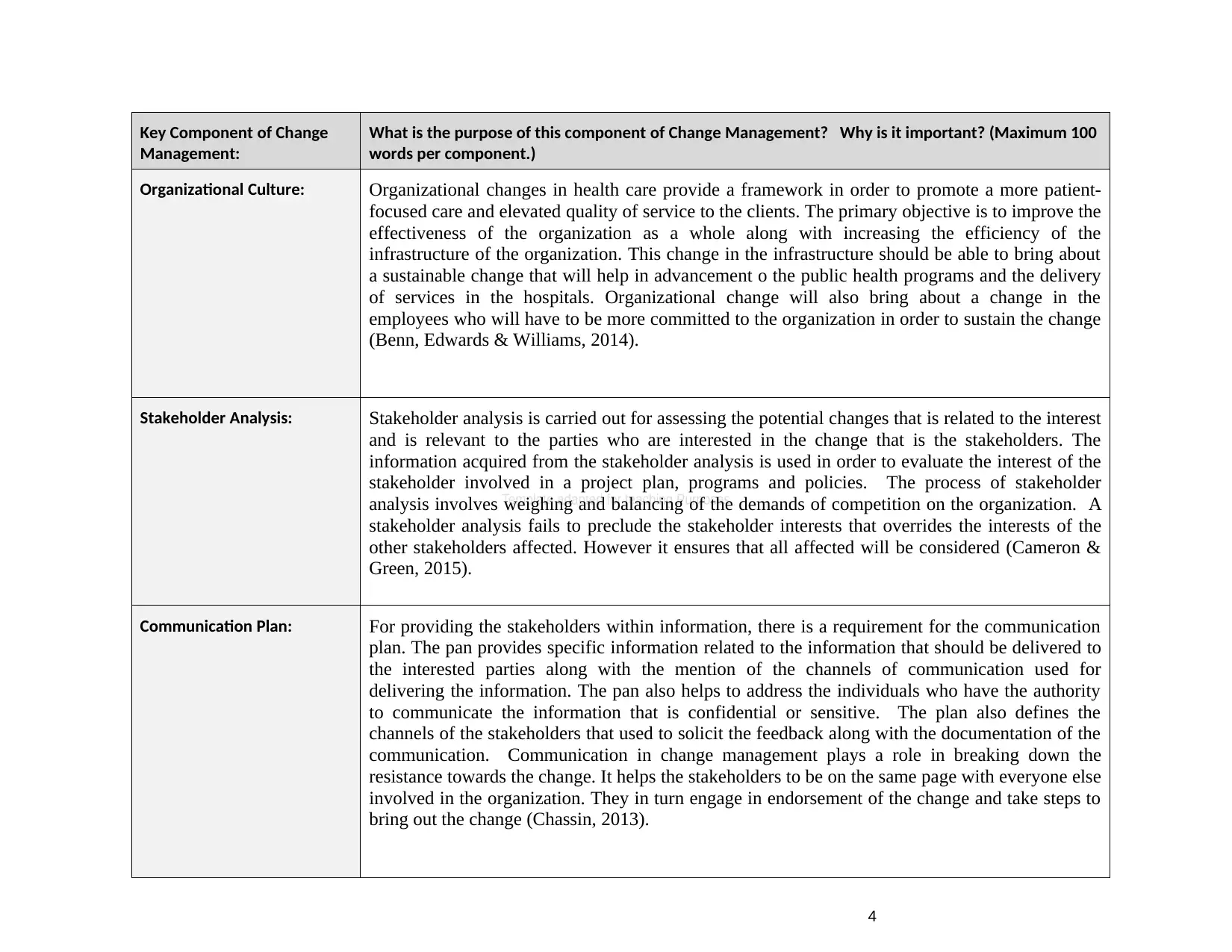
Key Component of Change
Management:
What is the purpose of this component of Change Management? Why is it important? (Maximum 100
words per component.)
Organizational Culture: Organizational changes in health care provide a framework in order to promote a more patient-
focused care and elevated quality of service to the clients. The primary objective is to improve the
effectiveness of the organization as a whole along with increasing the efficiency of the
infrastructure of the organization. This change in the infrastructure should be able to bring about
a sustainable change that will help in advancement o the public health programs and the delivery
of services in the hospitals. Organizational change will also bring about a change in the
employees who will have to be more committed to the organization in order to sustain the change
(Benn, Edwards & Williams, 2014).
Stakeholder Analysis: Stakeholder analysis is carried out for assessing the potential changes that is related to the interest
and is relevant to the parties who are interested in the change that is the stakeholders. The
information acquired from the stakeholder analysis is used in order to evaluate the interest of the
stakeholder involved in a project plan, programs and policies. The process of stakeholder
analysis involves weighing and balancing of the demands of competition on the organization. A
stakeholder analysis fails to preclude the stakeholder interests that overrides the interests of the
other stakeholders affected. However it ensures that all affected will be considered (Cameron &
Green, 2015).
Communication Plan: For providing the stakeholders within information, there is a requirement for the communication
plan. The pan provides specific information related to the information that should be delivered to
the interested parties along with the mention of the channels of communication used for
delivering the information. The pan also helps to address the individuals who have the authority
to communicate the information that is confidential or sensitive. The plan also defines the
channels of the stakeholders that used to solicit the feedback along with the documentation of the
communication. Communication in change management plays a role in breaking down the
resistance towards the change. It helps the stakeholders to be on the same page with everyone else
involved in the organization. They in turn engage in endorsement of the change and take steps to
bring out the change (Chassin, 2013).
4
Management:
What is the purpose of this component of Change Management? Why is it important? (Maximum 100
words per component.)
Organizational Culture: Organizational changes in health care provide a framework in order to promote a more patient-
focused care and elevated quality of service to the clients. The primary objective is to improve the
effectiveness of the organization as a whole along with increasing the efficiency of the
infrastructure of the organization. This change in the infrastructure should be able to bring about
a sustainable change that will help in advancement o the public health programs and the delivery
of services in the hospitals. Organizational change will also bring about a change in the
employees who will have to be more committed to the organization in order to sustain the change
(Benn, Edwards & Williams, 2014).
Stakeholder Analysis: Stakeholder analysis is carried out for assessing the potential changes that is related to the interest
and is relevant to the parties who are interested in the change that is the stakeholders. The
information acquired from the stakeholder analysis is used in order to evaluate the interest of the
stakeholder involved in a project plan, programs and policies. The process of stakeholder
analysis involves weighing and balancing of the demands of competition on the organization. A
stakeholder analysis fails to preclude the stakeholder interests that overrides the interests of the
other stakeholders affected. However it ensures that all affected will be considered (Cameron &
Green, 2015).
Communication Plan: For providing the stakeholders within information, there is a requirement for the communication
plan. The pan provides specific information related to the information that should be delivered to
the interested parties along with the mention of the channels of communication used for
delivering the information. The pan also helps to address the individuals who have the authority
to communicate the information that is confidential or sensitive. The plan also defines the
channels of the stakeholders that used to solicit the feedback along with the documentation of the
communication. Communication in change management plays a role in breaking down the
resistance towards the change. It helps the stakeholders to be on the same page with everyone else
involved in the organization. They in turn engage in endorsement of the change and take steps to
bring out the change (Chassin, 2013).
4
Paraphrase This Document
Need a fresh take? Get an instant paraphrase of this document with our AI Paraphraser
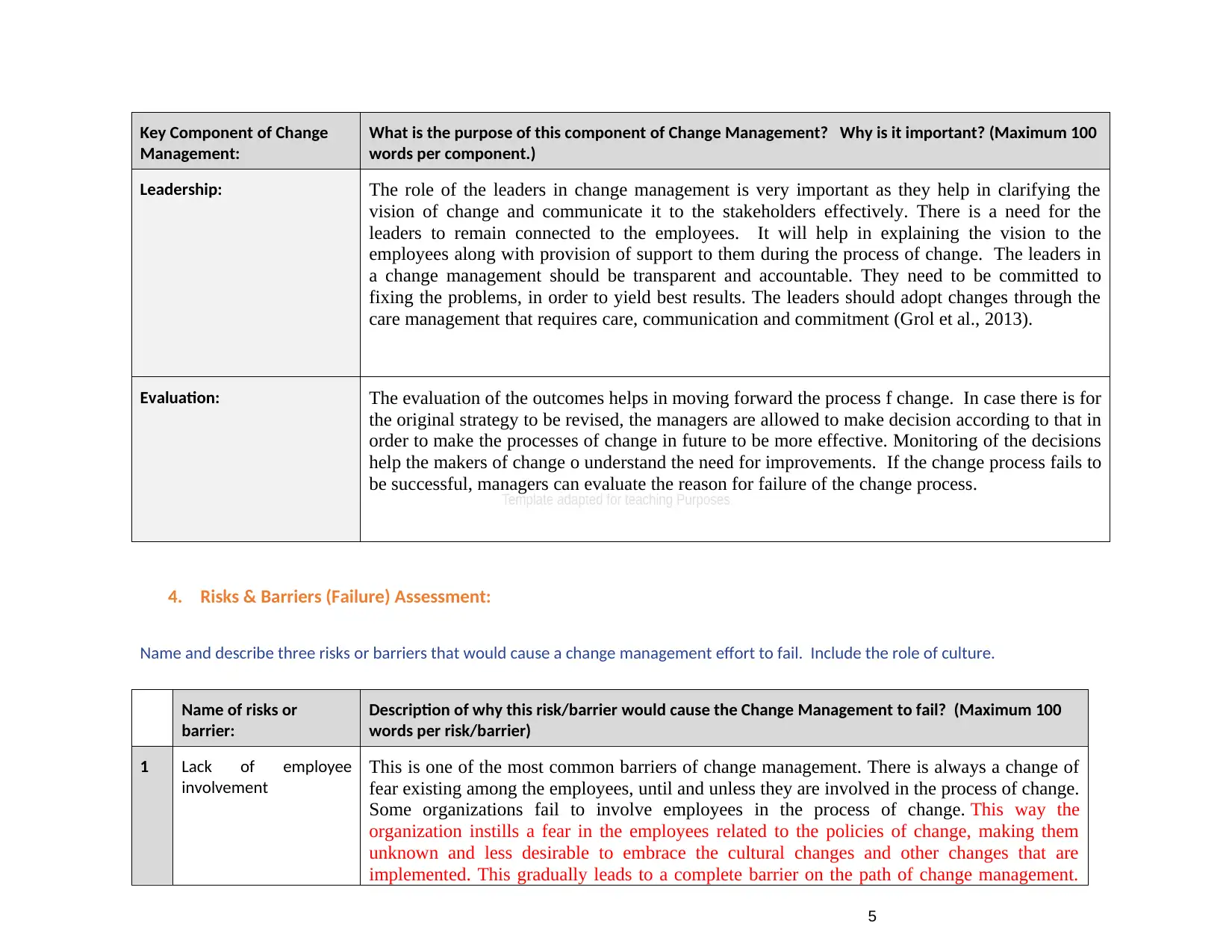
Key Component of Change
Management:
What is the purpose of this component of Change Management? Why is it important? (Maximum 100
words per component.)
Leadership: The role of the leaders in change management is very important as they help in clarifying the
vision of change and communicate it to the stakeholders effectively. There is a need for the
leaders to remain connected to the employees. It will help in explaining the vision to the
employees along with provision of support to them during the process of change. The leaders in
a change management should be transparent and accountable. They need to be committed to
fixing the problems, in order to yield best results. The leaders should adopt changes through the
care management that requires care, communication and commitment (Grol et al., 2013).
Evaluation: The evaluation of the outcomes helps in moving forward the process f change. In case there is for
the original strategy to be revised, the managers are allowed to make decision according to that in
order to make the processes of change in future to be more effective. Monitoring of the decisions
help the makers of change o understand the need for improvements. If the change process fails to
be successful, managers can evaluate the reason for failure of the change process.
4. Risks & Barriers (Failure) Assessment:
Name and describe three risks or barriers that would cause a change management effort to fail. Include the role of culture.
Name of risks or
barrier:
Description of why this risk/barrier would cause the Change Management to fail? (Maximum 100
words per risk/barrier)
1 Lack of employee
involvement
This is one of the most common barriers of change management. There is always a change of
fear existing among the employees, until and unless they are involved in the process of change.
Some organizations fail to involve employees in the process of change. This way the
organization instills a fear in the employees related to the policies of change, making them
unknown and less desirable to embrace the cultural changes and other changes that are
implemented. This gradually leads to a complete barrier on the path of change management.
5
Management:
What is the purpose of this component of Change Management? Why is it important? (Maximum 100
words per component.)
Leadership: The role of the leaders in change management is very important as they help in clarifying the
vision of change and communicate it to the stakeholders effectively. There is a need for the
leaders to remain connected to the employees. It will help in explaining the vision to the
employees along with provision of support to them during the process of change. The leaders in
a change management should be transparent and accountable. They need to be committed to
fixing the problems, in order to yield best results. The leaders should adopt changes through the
care management that requires care, communication and commitment (Grol et al., 2013).
Evaluation: The evaluation of the outcomes helps in moving forward the process f change. In case there is for
the original strategy to be revised, the managers are allowed to make decision according to that in
order to make the processes of change in future to be more effective. Monitoring of the decisions
help the makers of change o understand the need for improvements. If the change process fails to
be successful, managers can evaluate the reason for failure of the change process.
4. Risks & Barriers (Failure) Assessment:
Name and describe three risks or barriers that would cause a change management effort to fail. Include the role of culture.
Name of risks or
barrier:
Description of why this risk/barrier would cause the Change Management to fail? (Maximum 100
words per risk/barrier)
1 Lack of employee
involvement
This is one of the most common barriers of change management. There is always a change of
fear existing among the employees, until and unless they are involved in the process of change.
Some organizations fail to involve employees in the process of change. This way the
organization instills a fear in the employees related to the policies of change, making them
unknown and less desirable to embrace the cultural changes and other changes that are
implemented. This gradually leads to a complete barrier on the path of change management.
5
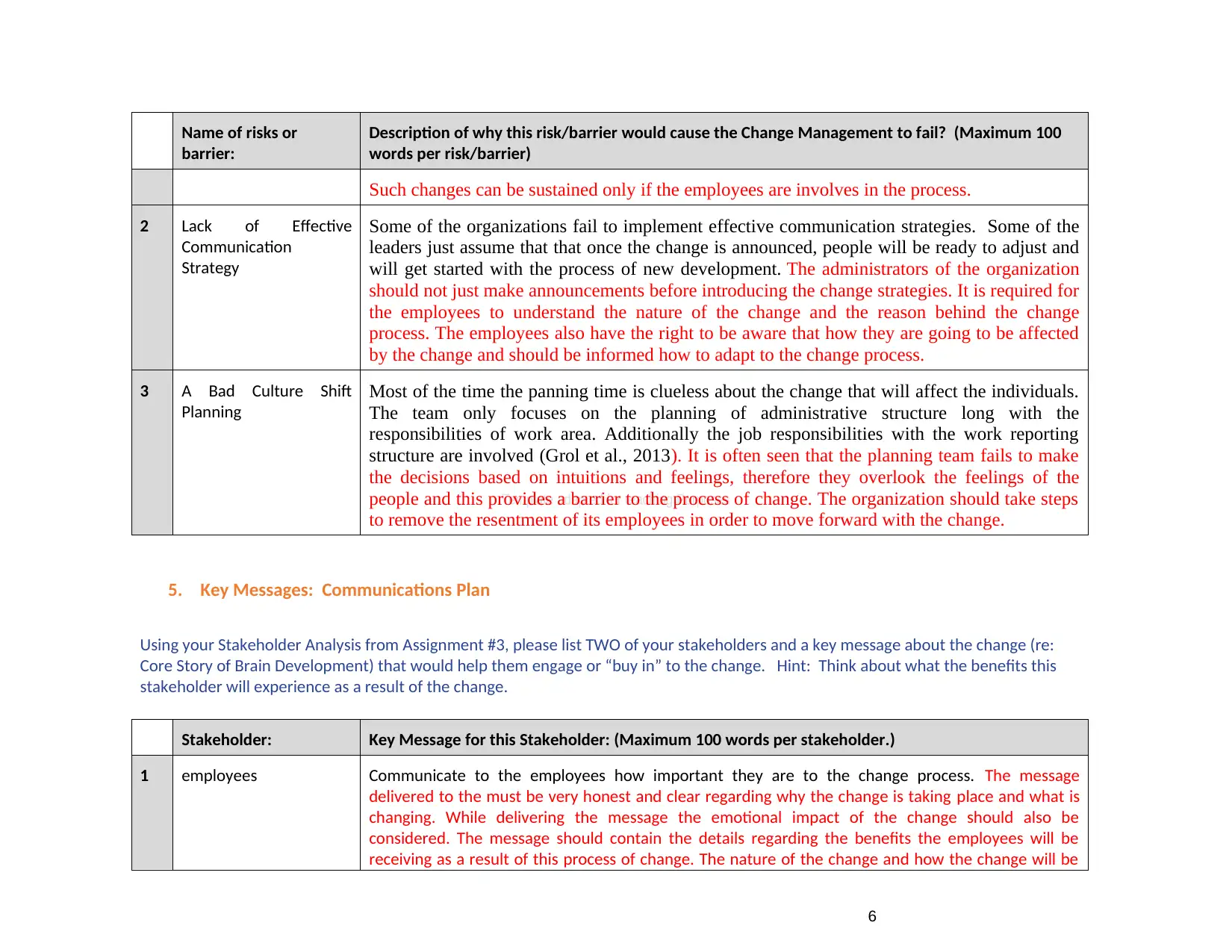
Name of risks or
barrier:
Description of why this risk/barrier would cause the Change Management to fail? (Maximum 100
words per risk/barrier)
Such changes can be sustained only if the employees are involves in the process.
2 Lack of Effective
Communication
Strategy
Some of the organizations fail to implement effective communication strategies. Some of the
leaders just assume that that once the change is announced, people will be ready to adjust and
will get started with the process of new development. The administrators of the organization
should not just make announcements before introducing the change strategies. It is required for
the employees to understand the nature of the change and the reason behind the change
process. The employees also have the right to be aware that how they are going to be affected
by the change and should be informed how to adapt to the change process.
3 A Bad Culture Shift
Planning
Most of the time the panning time is clueless about the change that will affect the individuals.
The team only focuses on the planning of administrative structure long with the
responsibilities of work area. Additionally the job responsibilities with the work reporting
structure are involved (Grol et al., 2013). It is often seen that the planning team fails to make
the decisions based on intuitions and feelings, therefore they overlook the feelings of the
people and this provides a barrier to the process of change. The organization should take steps
to remove the resentment of its employees in order to move forward with the change.
5. Key Messages: Communications Plan
Using your Stakeholder Analysis from Assignment #3, please list TWO of your stakeholders and a key message about the change (re:
Core Story of Brain Development) that would help them engage or “buy in” to the change. Hint: Think about what the benefits this
stakeholder will experience as a result of the change.
Stakeholder: Key Message for this Stakeholder: (Maximum 100 words per stakeholder.)
1 employees Communicate to the employees how important they are to the change process. The message
delivered to the must be very honest and clear regarding why the change is taking place and what is
changing. While delivering the message the emotional impact of the change should also be
considered. The message should contain the details regarding the benefits the employees will be
receiving as a result of this process of change. The nature of the change and how the change will be
6
barrier:
Description of why this risk/barrier would cause the Change Management to fail? (Maximum 100
words per risk/barrier)
Such changes can be sustained only if the employees are involves in the process.
2 Lack of Effective
Communication
Strategy
Some of the organizations fail to implement effective communication strategies. Some of the
leaders just assume that that once the change is announced, people will be ready to adjust and
will get started with the process of new development. The administrators of the organization
should not just make announcements before introducing the change strategies. It is required for
the employees to understand the nature of the change and the reason behind the change
process. The employees also have the right to be aware that how they are going to be affected
by the change and should be informed how to adapt to the change process.
3 A Bad Culture Shift
Planning
Most of the time the panning time is clueless about the change that will affect the individuals.
The team only focuses on the planning of administrative structure long with the
responsibilities of work area. Additionally the job responsibilities with the work reporting
structure are involved (Grol et al., 2013). It is often seen that the planning team fails to make
the decisions based on intuitions and feelings, therefore they overlook the feelings of the
people and this provides a barrier to the process of change. The organization should take steps
to remove the resentment of its employees in order to move forward with the change.
5. Key Messages: Communications Plan
Using your Stakeholder Analysis from Assignment #3, please list TWO of your stakeholders and a key message about the change (re:
Core Story of Brain Development) that would help them engage or “buy in” to the change. Hint: Think about what the benefits this
stakeholder will experience as a result of the change.
Stakeholder: Key Message for this Stakeholder: (Maximum 100 words per stakeholder.)
1 employees Communicate to the employees how important they are to the change process. The message
delivered to the must be very honest and clear regarding why the change is taking place and what is
changing. While delivering the message the emotional impact of the change should also be
considered. The message should contain the details regarding the benefits the employees will be
receiving as a result of this process of change. The nature of the change and how the change will be
6
⊘ This is a preview!⊘
Do you want full access?
Subscribe today to unlock all pages.

Trusted by 1+ million students worldwide
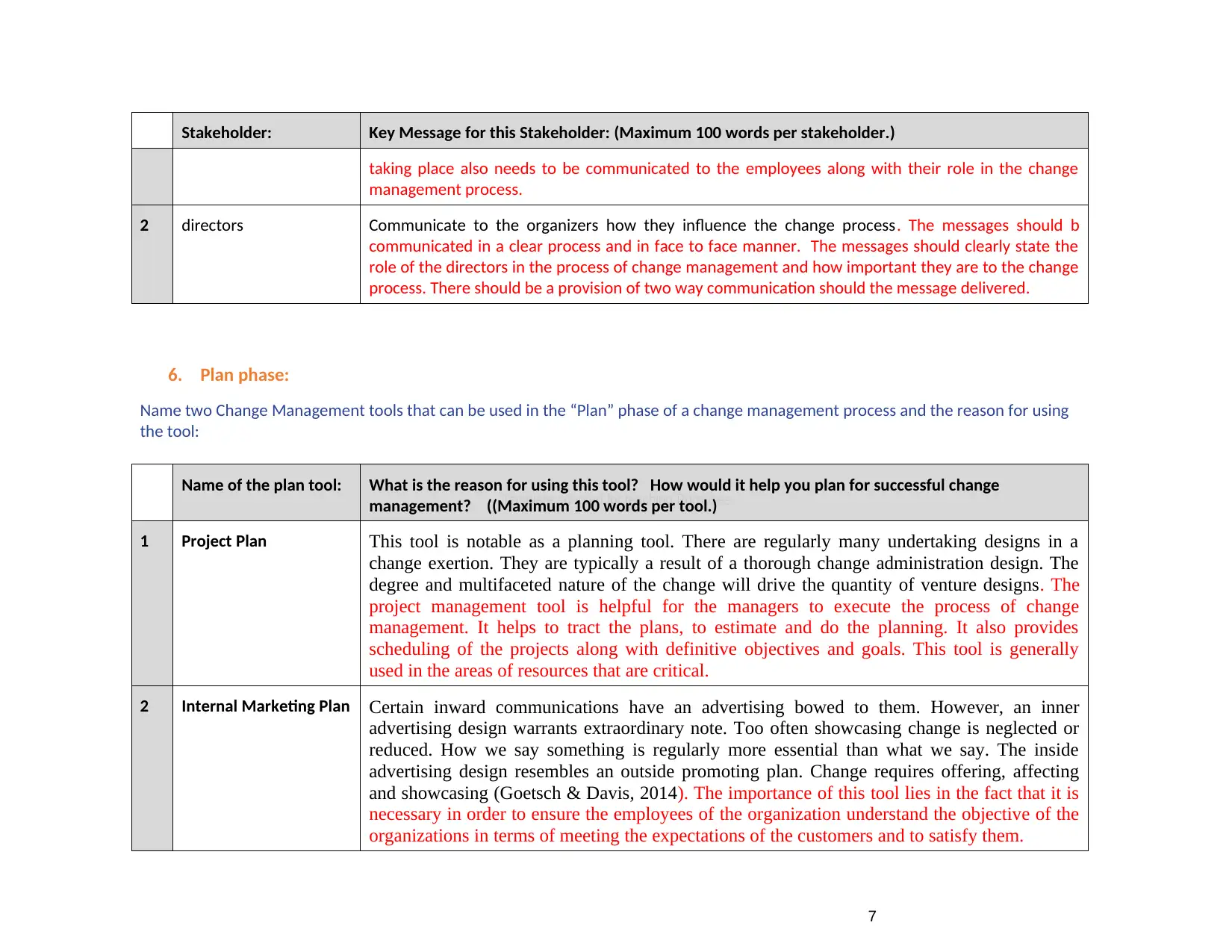
Stakeholder: Key Message for this Stakeholder: (Maximum 100 words per stakeholder.)
taking place also needs to be communicated to the employees along with their role in the change
management process.
2 directors Communicate to the organizers how they influence the change process. The messages should b
communicated in a clear process and in face to face manner. The messages should clearly state the
role of the directors in the process of change management and how important they are to the change
process. There should be a provision of two way communication should the message delivered.
6. Plan phase:
Name two Change Management tools that can be used in the “Plan” phase of a change management process and the reason for using
the tool:
Name of the plan tool: What is the reason for using this tool? How would it help you plan for successful change
management? ((Maximum 100 words per tool.)
1 Project Plan This tool is notable as a planning tool. There are regularly many undertaking designs in a
change exertion. They are typically a result of a thorough change administration design. The
degree and multifaceted nature of the change will drive the quantity of venture designs. The
project management tool is helpful for the managers to execute the process of change
management. It helps to tract the plans, to estimate and do the planning. It also provides
scheduling of the projects along with definitive objectives and goals. This tool is generally
used in the areas of resources that are critical.
2 Internal Marketing Plan Certain inward communications have an advertising bowed to them. However, an inner
advertising design warrants extraordinary note. Too often showcasing change is neglected or
reduced. How we say something is regularly more essential than what we say. The inside
advertising design resembles an outside promoting plan. Change requires offering, affecting
and showcasing (Goetsch & Davis, 2014). The importance of this tool lies in the fact that it is
necessary in order to ensure the employees of the organization understand the objective of the
organizations in terms of meeting the expectations of the customers and to satisfy them.
7
taking place also needs to be communicated to the employees along with their role in the change
management process.
2 directors Communicate to the organizers how they influence the change process. The messages should b
communicated in a clear process and in face to face manner. The messages should clearly state the
role of the directors in the process of change management and how important they are to the change
process. There should be a provision of two way communication should the message delivered.
6. Plan phase:
Name two Change Management tools that can be used in the “Plan” phase of a change management process and the reason for using
the tool:
Name of the plan tool: What is the reason for using this tool? How would it help you plan for successful change
management? ((Maximum 100 words per tool.)
1 Project Plan This tool is notable as a planning tool. There are regularly many undertaking designs in a
change exertion. They are typically a result of a thorough change administration design. The
degree and multifaceted nature of the change will drive the quantity of venture designs. The
project management tool is helpful for the managers to execute the process of change
management. It helps to tract the plans, to estimate and do the planning. It also provides
scheduling of the projects along with definitive objectives and goals. This tool is generally
used in the areas of resources that are critical.
2 Internal Marketing Plan Certain inward communications have an advertising bowed to them. However, an inner
advertising design warrants extraordinary note. Too often showcasing change is neglected or
reduced. How we say something is regularly more essential than what we say. The inside
advertising design resembles an outside promoting plan. Change requires offering, affecting
and showcasing (Goetsch & Davis, 2014). The importance of this tool lies in the fact that it is
necessary in order to ensure the employees of the organization understand the objective of the
organizations in terms of meeting the expectations of the customers and to satisfy them.
7
Paraphrase This Document
Need a fresh take? Get an instant paraphrase of this document with our AI Paraphraser
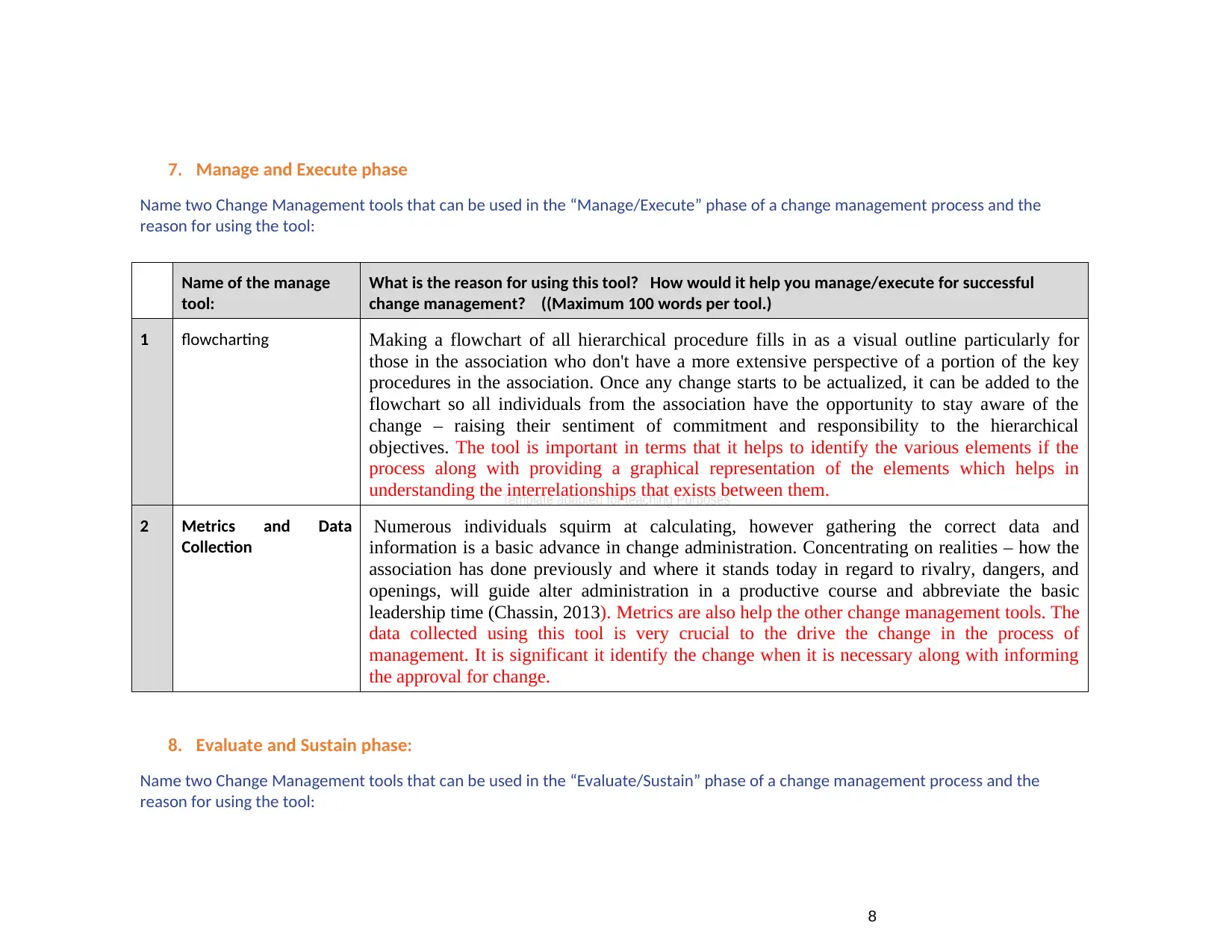
7. Manage and Execute phase
Name two Change Management tools that can be used in the “Manage/Execute” phase of a change management process and the
reason for using the tool:
Name of the manage
tool:
What is the reason for using this tool? How would it help you manage/execute for successful
change management? ((Maximum 100 words per tool.)
1 flowcharting Making a flowchart of all hierarchical procedure fills in as a visual outline particularly for
those in the association who don't have a more extensive perspective of a portion of the key
procedures in the association. Once any change starts to be actualized, it can be added to the
flowchart so all individuals from the association have the opportunity to stay aware of the
change – raising their sentiment of commitment and responsibility to the hierarchical
objectives. The tool is important in terms that it helps to identify the various elements if the
process along with providing a graphical representation of the elements which helps in
understanding the interrelationships that exists between them.
2 Metrics and Data
Collection
Numerous individuals squirm at calculating, however gathering the correct data and
information is a basic advance in change administration. Concentrating on realities – how the
association has done previously and where it stands today in regard to rivalry, dangers, and
openings, will guide alter administration in a productive course and abbreviate the basic
leadership time (Chassin, 2013). Metrics are also help the other change management tools. The
data collected using this tool is very crucial to the drive the change in the process of
management. It is significant it identify the change when it is necessary along with informing
the approval for change.
8. Evaluate and Sustain phase:
Name two Change Management tools that can be used in the “Evaluate/Sustain” phase of a change management process and the
reason for using the tool:
8
Name two Change Management tools that can be used in the “Manage/Execute” phase of a change management process and the
reason for using the tool:
Name of the manage
tool:
What is the reason for using this tool? How would it help you manage/execute for successful
change management? ((Maximum 100 words per tool.)
1 flowcharting Making a flowchart of all hierarchical procedure fills in as a visual outline particularly for
those in the association who don't have a more extensive perspective of a portion of the key
procedures in the association. Once any change starts to be actualized, it can be added to the
flowchart so all individuals from the association have the opportunity to stay aware of the
change – raising their sentiment of commitment and responsibility to the hierarchical
objectives. The tool is important in terms that it helps to identify the various elements if the
process along with providing a graphical representation of the elements which helps in
understanding the interrelationships that exists between them.
2 Metrics and Data
Collection
Numerous individuals squirm at calculating, however gathering the correct data and
information is a basic advance in change administration. Concentrating on realities – how the
association has done previously and where it stands today in regard to rivalry, dangers, and
openings, will guide alter administration in a productive course and abbreviate the basic
leadership time (Chassin, 2013). Metrics are also help the other change management tools. The
data collected using this tool is very crucial to the drive the change in the process of
management. It is significant it identify the change when it is necessary along with informing
the approval for change.
8. Evaluate and Sustain phase:
Name two Change Management tools that can be used in the “Evaluate/Sustain” phase of a change management process and the
reason for using the tool:
8
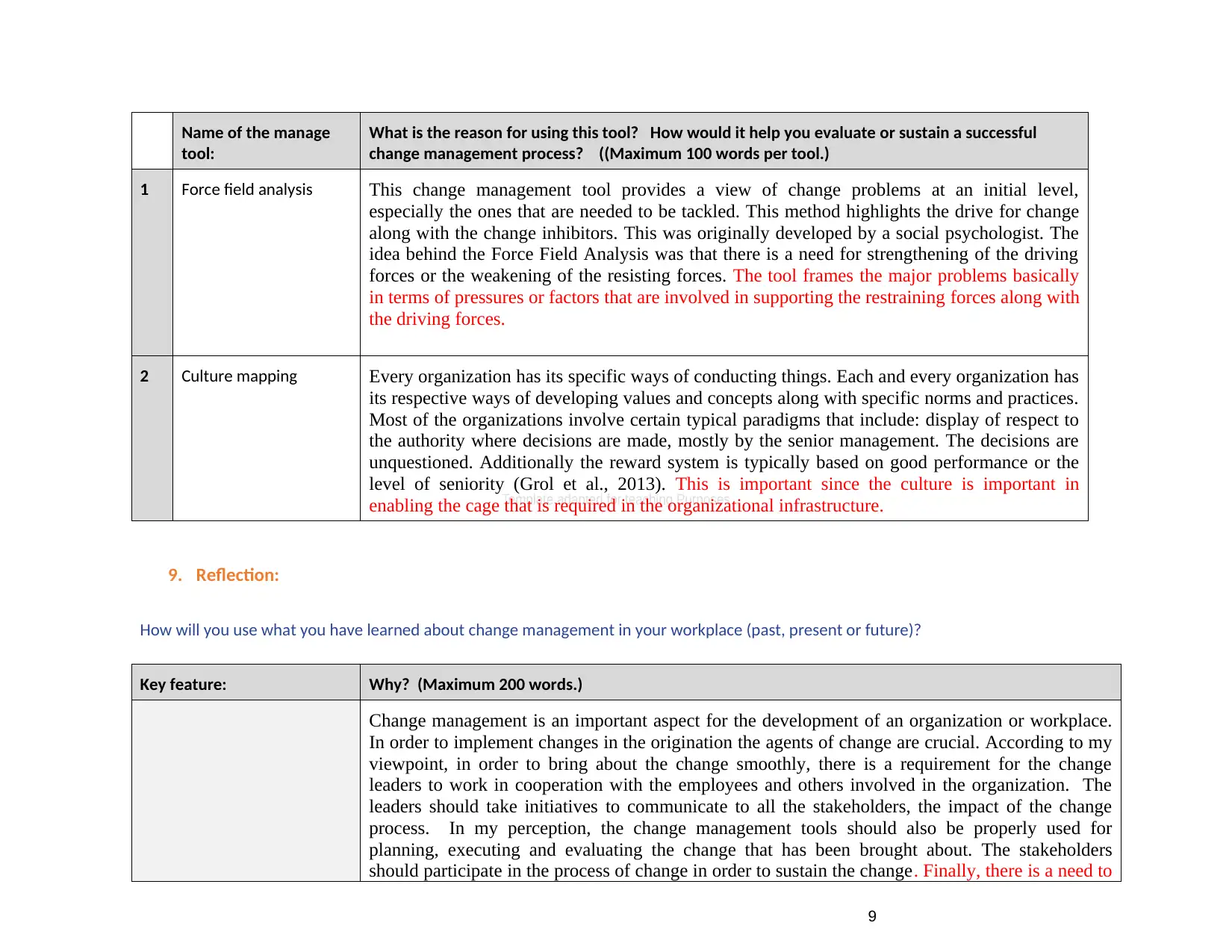
Name of the manage
tool:
What is the reason for using this tool? How would it help you evaluate or sustain a successful
change management process? ((Maximum 100 words per tool.)
1 Force field analysis This change management tool provides a view of change problems at an initial level,
especially the ones that are needed to be tackled. This method highlights the drive for change
along with the change inhibitors. This was originally developed by a social psychologist. The
idea behind the Force Field Analysis was that there is a need for strengthening of the driving
forces or the weakening of the resisting forces. The tool frames the major problems basically
in terms of pressures or factors that are involved in supporting the restraining forces along with
the driving forces.
2 Culture mapping Every organization has its specific ways of conducting things. Each and every organization has
its respective ways of developing values and concepts along with specific norms and practices.
Most of the organizations involve certain typical paradigms that include: display of respect to
the authority where decisions are made, mostly by the senior management. The decisions are
unquestioned. Additionally the reward system is typically based on good performance or the
level of seniority (Grol et al., 2013). This is important since the culture is important in
enabling the cage that is required in the organizational infrastructure.
9. Reflection:
How will you use what you have learned about change management in your workplace (past, present or future)?
Key feature: Why? (Maximum 200 words.)
Change management is an important aspect for the development of an organization or workplace.
In order to implement changes in the origination the agents of change are crucial. According to my
viewpoint, in order to bring about the change smoothly, there is a requirement for the change
leaders to work in cooperation with the employees and others involved in the organization. The
leaders should take initiatives to communicate to all the stakeholders, the impact of the change
process. In my perception, the change management tools should also be properly used for
planning, executing and evaluating the change that has been brought about. The stakeholders
should participate in the process of change in order to sustain the change. Finally, there is a need to
9
tool:
What is the reason for using this tool? How would it help you evaluate or sustain a successful
change management process? ((Maximum 100 words per tool.)
1 Force field analysis This change management tool provides a view of change problems at an initial level,
especially the ones that are needed to be tackled. This method highlights the drive for change
along with the change inhibitors. This was originally developed by a social psychologist. The
idea behind the Force Field Analysis was that there is a need for strengthening of the driving
forces or the weakening of the resisting forces. The tool frames the major problems basically
in terms of pressures or factors that are involved in supporting the restraining forces along with
the driving forces.
2 Culture mapping Every organization has its specific ways of conducting things. Each and every organization has
its respective ways of developing values and concepts along with specific norms and practices.
Most of the organizations involve certain typical paradigms that include: display of respect to
the authority where decisions are made, mostly by the senior management. The decisions are
unquestioned. Additionally the reward system is typically based on good performance or the
level of seniority (Grol et al., 2013). This is important since the culture is important in
enabling the cage that is required in the organizational infrastructure.
9. Reflection:
How will you use what you have learned about change management in your workplace (past, present or future)?
Key feature: Why? (Maximum 200 words.)
Change management is an important aspect for the development of an organization or workplace.
In order to implement changes in the origination the agents of change are crucial. According to my
viewpoint, in order to bring about the change smoothly, there is a requirement for the change
leaders to work in cooperation with the employees and others involved in the organization. The
leaders should take initiatives to communicate to all the stakeholders, the impact of the change
process. In my perception, the change management tools should also be properly used for
planning, executing and evaluating the change that has been brought about. The stakeholders
should participate in the process of change in order to sustain the change. Finally, there is a need to
9
⊘ This is a preview!⊘
Do you want full access?
Subscribe today to unlock all pages.

Trusted by 1+ million students worldwide
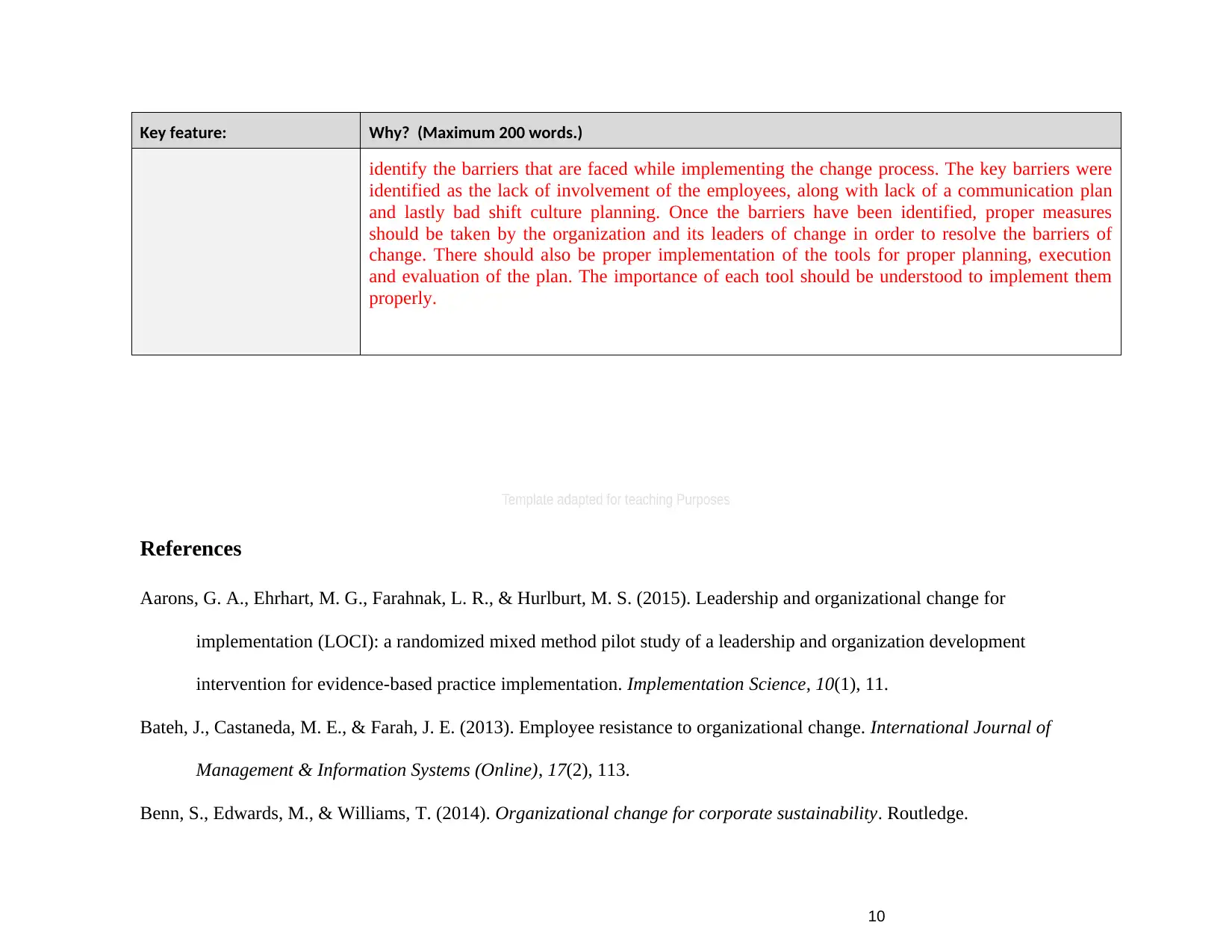
Key feature: Why? (Maximum 200 words.)
identify the barriers that are faced while implementing the change process. The key barriers were
identified as the lack of involvement of the employees, along with lack of a communication plan
and lastly bad shift culture planning. Once the barriers have been identified, proper measures
should be taken by the organization and its leaders of change in order to resolve the barriers of
change. There should also be proper implementation of the tools for proper planning, execution
and evaluation of the plan. The importance of each tool should be understood to implement them
properly.
References
Aarons, G. A., Ehrhart, M. G., Farahnak, L. R., & Hurlburt, M. S. (2015). Leadership and organizational change for
implementation (LOCI): a randomized mixed method pilot study of a leadership and organization development
intervention for evidence-based practice implementation. Implementation Science, 10(1), 11.
Bateh, J., Castaneda, M. E., & Farah, J. E. (2013). Employee resistance to organizational change. International Journal of
Management & Information Systems (Online), 17(2), 113.
Benn, S., Edwards, M., & Williams, T. (2014). Organizational change for corporate sustainability. Routledge.
10
identify the barriers that are faced while implementing the change process. The key barriers were
identified as the lack of involvement of the employees, along with lack of a communication plan
and lastly bad shift culture planning. Once the barriers have been identified, proper measures
should be taken by the organization and its leaders of change in order to resolve the barriers of
change. There should also be proper implementation of the tools for proper planning, execution
and evaluation of the plan. The importance of each tool should be understood to implement them
properly.
References
Aarons, G. A., Ehrhart, M. G., Farahnak, L. R., & Hurlburt, M. S. (2015). Leadership and organizational change for
implementation (LOCI): a randomized mixed method pilot study of a leadership and organization development
intervention for evidence-based practice implementation. Implementation Science, 10(1), 11.
Bateh, J., Castaneda, M. E., & Farah, J. E. (2013). Employee resistance to organizational change. International Journal of
Management & Information Systems (Online), 17(2), 113.
Benn, S., Edwards, M., & Williams, T. (2014). Organizational change for corporate sustainability. Routledge.
10
Paraphrase This Document
Need a fresh take? Get an instant paraphrase of this document with our AI Paraphraser
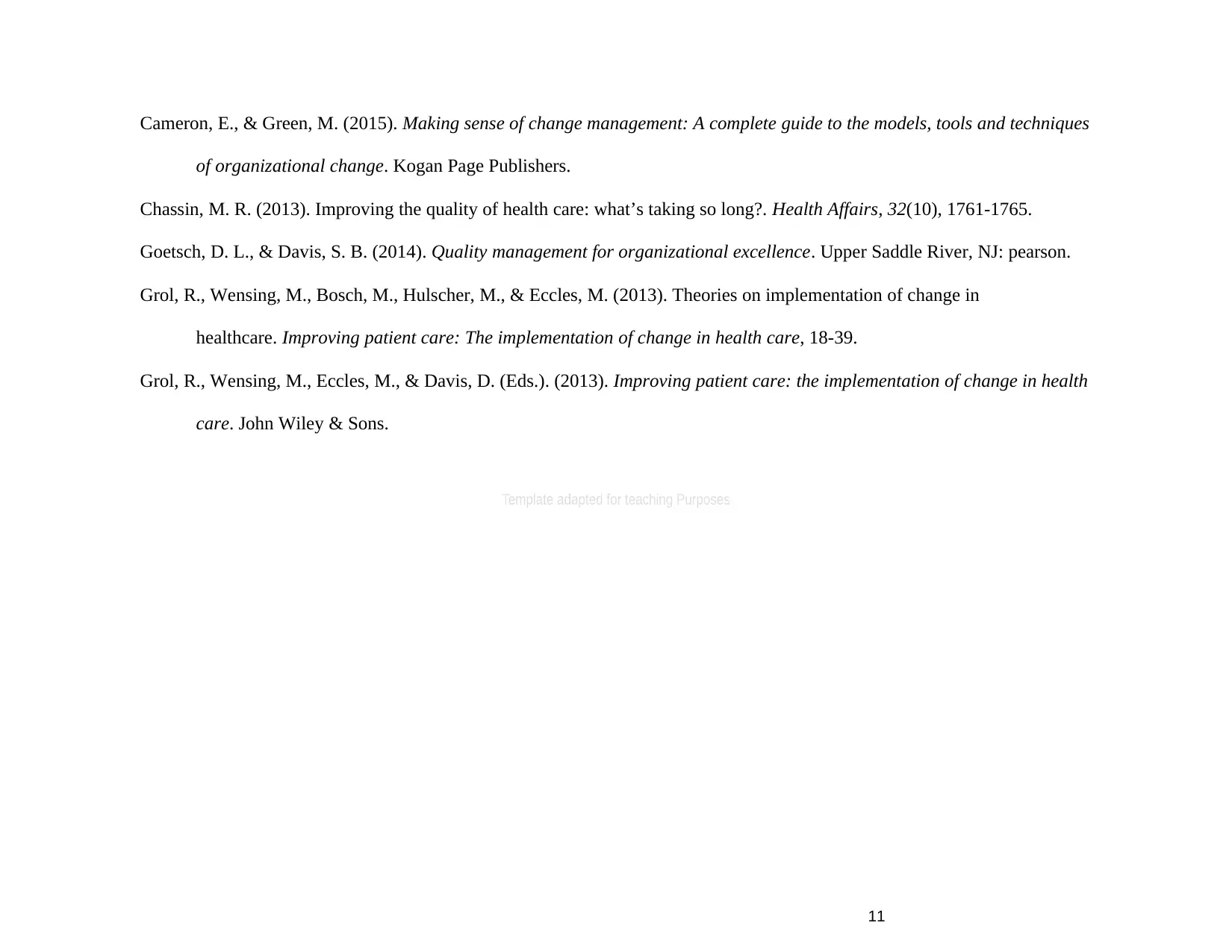
Cameron, E., & Green, M. (2015). Making sense of change management: A complete guide to the models, tools and techniques
of organizational change. Kogan Page Publishers.
Chassin, M. R. (2013). Improving the quality of health care: what’s taking so long?. Health Affairs, 32(10), 1761-1765.
Goetsch, D. L., & Davis, S. B. (2014). Quality management for organizational excellence. Upper Saddle River, NJ: pearson.
Grol, R., Wensing, M., Bosch, M., Hulscher, M., & Eccles, M. (2013). Theories on implementation of change in
healthcare. Improving patient care: The implementation of change in health care, 18-39.
Grol, R., Wensing, M., Eccles, M., & Davis, D. (Eds.). (2013). Improving patient care: the implementation of change in health
care. John Wiley & Sons.
11
of organizational change. Kogan Page Publishers.
Chassin, M. R. (2013). Improving the quality of health care: what’s taking so long?. Health Affairs, 32(10), 1761-1765.
Goetsch, D. L., & Davis, S. B. (2014). Quality management for organizational excellence. Upper Saddle River, NJ: pearson.
Grol, R., Wensing, M., Bosch, M., Hulscher, M., & Eccles, M. (2013). Theories on implementation of change in
healthcare. Improving patient care: The implementation of change in health care, 18-39.
Grol, R., Wensing, M., Eccles, M., & Davis, D. (Eds.). (2013). Improving patient care: the implementation of change in health
care. John Wiley & Sons.
11
1 out of 11
Related Documents
Your All-in-One AI-Powered Toolkit for Academic Success.
+13062052269
info@desklib.com
Available 24*7 on WhatsApp / Email
![[object Object]](/_next/static/media/star-bottom.7253800d.svg)
Unlock your academic potential
Copyright © 2020–2025 A2Z Services. All Rights Reserved. Developed and managed by ZUCOL.





